| |
 |
|
 |
|
|
|
| |
|
|
|
The only surviving organ by Antonio Pace, 1631, in the Chapel of Nome di Dio,
Pesaro, Italy. Restoration by Fratelli Ruffatti, 1996 |
|
|
Fratelli Ruffatti is one of the leading restorers of historical organs in Italy, with more than forty years of intense experience and more than one hundred instruments completed. Restoration is very specialized work, requiring a high degree of skill. The original parts, no matter how badly damaged by woodworms, wear, time, corrosion or vandalism, must be perfectly returned to their original state and made functional, by preserving as much of the instrument as possible.
This process is also a one-time-only opportunity to obtain valuable information on the manufacturing practices of the original builder: after the work is completed, many of the interior parts can no longer be analyzed in detail. Thus, documenting not only the restoration process itself but also the technical information on the original parts becomes a priority. |
|
|
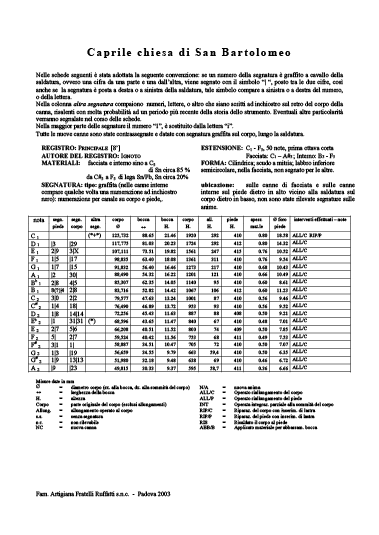 |
|
At Fratelli Ruffatti, we pay special attention to producing very detailed and complete documentation on each instrument under restoration. This includes the analysis of the metal alloy used by the original builder to manufacture the pipes, a complete inventory and description of the pipes, recording the intricate measurements of the various elements and, in selected projects, the computerized analysis of the sounds produced. The research is conducted with the most advanced technologies and equipment. |
|
|
| When taking apart a windchest for restoration, great care is devoted to keeping a record of all possible details in order to reproduce the original manufacturing techniques and procedures as closely as possible. An example is the placing in order of all the hand-forged nails extracted from the toeboards. Each hand-made nail is different from the next. It is important that the location of each is recorded so that it can be re-inserted in its original place. |
|
|
|
|
|
|
|
Treatment of the wood is an important part of any historical restoration. Woodworms of different species can totally disintegrate the wood or, at best, severely damage it. When this happens, we do not simply replace the old with the new, as this would mean the loss of important original elements. We instead consolidate the original parts, even when woodworms have left them with a sponge-like consistency. This detail of a windchest is from the Co-Cathedral of St John in Valletta, Malta, built in 1579. It shows extensive woodworm damage. After the chest is made solid again, we seal all wind channels perfectly with organic hot glue. Without any loss of the original, the restored parts will become operational once again, and will last for generations to come. |
|
|
|
|
|
|
| Before any attempt is made to consolidate the surviving parts and to fill in with new wood, however, it is essential to carry out an efficient disinfestation. Particularly demanding situations require highly sophisticated treatment. In 2004, Fratelli Ruffatti pioneered the use in pipe organ restoration of a truly innovative system, which was until then only used on a smaller scale for the restoration of old books or wooden artwork. The wooden parts of the entire instrument are placed inside a thermo-sealed plastic envelope, from which all air is extracted. Nitrogen is then introduced in its place, and the residual oxygen content, at a level of less than one per cent, is monitored by a computer. The wood is kept inside this envelope for one month, at constant temperature. After all of this is done, the wood is further treated with an innovative liquid which is non-toxic to humans but will make the wood poisonous to parasites. This liquid has the same effect on wood as water, neither altering nor coloring its fibers. |
|
|
|
|
A keyboard before and after restoration. All possible original parts have been preserved and restored. New parts that are necessary are made from the same type of wood and key covering material as the original. |
|
|
|
|
|
|
When necessary, keyboards are built new as exact copies of the old, taking all the needed information from surviving instruments manufactured by the same builder. Even the smallest detail is faithfully reproduced. This keyboard was built for the parish Church of S. Andrea in Lion (Padova), Italy. it is one of the few surviving organs by Girolamo Zavarise, built between 1790 and 1791. The keyboard is an exact copy from a Zavarise organ built in 1785. Key coverings for the naturals are made of European boxwood, while sharps are of walnut with ebony and bone overlays. |
|
|
| Perishable materials, in most cases, must be replaced during the restoration process. At Fratelli Ruffatti this is done by utilizing the materials of the same type and by reproducing the original manufacturing techniques, down to the smallest detail. This way, the techniques used by the builder will be passed down to future generations. Here, naturally-tanned leather is being hand-sewn to reproduce the original leather seals. |
|
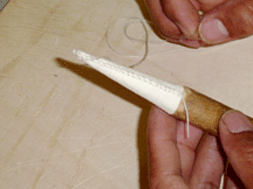
|
|
|
|
|
|
| It is not uncommon, on an organ restoration, to find pipes that have been vandalized: stepped on, broken, or twisted. At Fratelli Ruffatti nothing is unrestorable. We take the utmost care in restoring the original shape of even the most damaged pipes, resoldering them where broken, while respecting at much as possible their original parameters. The above pipes are from the organ in Cervia Cathedral, built by Giuseppe Cipriani in 1840. As part of the restoration process, the resonators have been lengthened with homogeneous metal to restore the original pitch and temperament. |
|
|
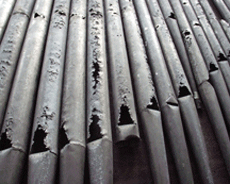 |
A good example of the extreme conditions of pipes and of the painstaking care in restoring them is offered by the façade pipes of the organ at the Co-Cathedral of St. John, in Valletta, Malta, built in 1579 and attributed to Raffaele La Valle of Palermo. The corrosion of tin was severe, and restoration was an almost impossible task. |
|
|
|
|
|
|
| After restoration, the pipes were analyzed in the dark chamber to locate microholes, by inserting high intensity light inside their resonators. The photo above left shows the white light shining through the microholes. Once these tiny openings are repaired, the pipe will play as it did originally. At right is the restored façade of the organ in Valletta, Malta, in all of its splendor. Not one pipe was discarded in the restoration process. |
|
|
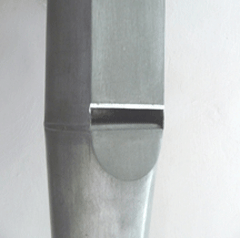 |
|
Quite frequently ancient pipes have suffered structural alterations over the years due to improper revoicing. Some of these alterations are very severe, especially when part of the original material is lost. This is the case of alterations of the upper lip of the pipe, which is done by cutting away some of the metal from the upper lip. During restoration, the original level must be restored, to revive the correct sound character of the pipe. The normal, current practice on the smallest pipes is that of separating the pipe toe from the resonator, cutting away some of the metal at the base of the resonator and then re soldering the two elements. For the larger pipes, further cutting away of metal at the upper lip will provide room for a new metal insert. None of this is done at Fratelli Ruffatti. |
|
|
|
We utilize a method by which the restoration is performed in the most gentle way, with no loss of original material. A truly innovative technique allows us to attach new metal to the edge of the upper lip, without the need of further cutting. This way, the surviving length of the resonator is preserved. This is the most respectful technique, and an important contribution to preservation of antique pipework. It can be applied to pipes of all sizes, such as the ones at right, which have resonators slightly longer than one inch. The application of new metal is 0.8 mm wide. |
|
|
|
|
|
|
|
| Above left is the organ at Caprile (Belluno), originally built in 1660, before restoration. The instrument had been severely transformed during the 19th century to the point that the original configuration was not recognizable. The restoration of the original facade layout (above right) has been made possible by extensive research conducted on the surviving parts. |
|
|
|
|
|
The organ at S. Maria Maggiore in Miglionico (Matera), dates from the beginning of the 17th century, and was restored in 1994. Due to the collapsing of the church roof it had been exposed to rain and snow for an extensive period before being rescued. |
|
|
| The organ at S. Maria in Vallicella (Roma) was built by Giovanni Guglielmi in 1612 and was restored by Ruffatti in 2000. The beautiful 16-foot facade features a few pipes “a tortiglione”, made in the form of a threaded rod. |
|
|
|
|
|
|
|
Originally, the organ built by Nicola Abbate in 1780 into the Church of SS. Annunziata in Venafro (Isernia), had two “uccelliere” or nightingales. One of the originals had been lost and was reconstructed by Fratelli Ruffatti during restoration. These two groups of pipes speak into small a water filled container, faithfully reproducing the effect of birds singing. |
|
|
| The organ in the Church of La Vallicella in Rome is by Giovanni Guglielmi, built in 1612. It had been transformed over the years. Fratelli Ruffatti restored it to its original condition, including the rebuilding of the keyboard, which features the “double sharps” which are used in conjunction with the “mean tone” tuning temperament. |
|
|
|
| |
|
|
|
Some very unusual reed stops can be found in organs built by Gaetano Callido, the famous XVIII century builder of the Venetian school. The Tromboncini (second row) and Violoncelli (front row) are eight-foot stops with short resonators, of strange shapes and even more unusual sound. The Violoncelli in particular, feature cypress wood resonators and hand-carved boxwood shallots, a true work of art. The pipes are located in front of the façade so that the organist can easily access the stops for tuning. The photo is taken at the Callido organ in Corinaldo (Ancona), Monastery of l’Addolorata, whose Mother Superior, at the time of the original organ installation in 1766, was the daughter of Callido. |
|
|
| Drums in pipe organs? They were very common in Italy during the 19th century, an essential tool for the performance of the opera-style repertoire then composed to accompany the religious services. The photo is taken from the organ by Quirico Gennari, 1842, restored by Ruffatti in 2007 for the church of S. Benedetto in Faiano (Salerno). |
|
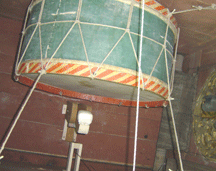 |
|
|
|
|
|
Typical “wedge type” bellows activated by wooden levers. These are from the organ in Miglionico (Matera), manufactured during the 17th century by an unknown builder. On all restoration projects Fratelli Ruffatti make the original hand pumping systems operational, in addition to providing a blower run by electricity. |
|
|
|
|
|
|
|
Organ by Gaetano Callido, 1767 in the Church of
S. Agostino, Corinaldo (Ancona)
Restored by Fratelli Ruffatti |
|
Senigalia (Ancona) Church of the Holy Cross - Opus 104 of Gaetano Callido, 1775. Restored by Fratelli Ruffatti in 1993 |
|
|
Books and videos on restoration projects by Fratelli Ruffatti include:
• L'ORGANO DI ANTONIO PACE, PESARO, 1631
FRANCESCO AND PIERO RUFFATTI, CO-AUTHORS. (TURRIS, ED.)
• L'ORGANO DI EUGENIO BIROLDI, BESANA, 1808-1810
B. ARRIGONI, M. MANZIN, F. RUFFATTI, AUTHORS
• L'ORGANO DELLA CATTEDRALE DI FELTRE. 1767-8
O. MISCHIATI, AUTHOR (PATRON, ED.)
• L'ORGANO DELLA CHIESA DI S. AGOSTINO IN CORINALDO, 1767
M. FERRANTE, AUTHOR
• L'ORGANO DELLA CHIESA ARCIPRETALE DI SANTA GIUSTINA BELLUNESE, 1766/1887
A. ALPAGOTTI, AUTHOR
• L'ORGANO DELLA BASILICA DI S. MARIA MAGGIORE A BERGAMO, 1915/1948
G. MORASCHINI, AUTHOR
• L'ANTICO ORGANO ADRIANO FEDRI, 1778 – CHIESA DI S. CHIARA, RIETI
G. BATTISTELLA, L. GENTILE, M. DI NISIO, A. MAMMARELLA, P. RUFFATTI, F. RUFFATTI, AUTHORS
• IL RESTAURO DELL'ORGANO GIROLAMO ZAVARISE, 1802
T. BATTISTI, A. CARLINI, P. DELAMA, D. ECCLI, G.F. FRISINGHELLI, F. RUFFATTI, G. TAIT, AUTHORS
• A JEWEL REBORN – A VIDEO CHRONICLE OF THE RESTORATION OF THE ORGAN IN THE CO-CATHEDRAL OF ST. JOHN, VALLETTA, MALTA, 1579
THE VALLETTA REHABILITATION PROJECT IN CONJUNCTION WITH FRATELLI RUFFATTI |
|
|
| Restored Organs |
|
|
Partial list of historical restorations performed by Fratelli Ruffatti |
|
Location, name of church |
Year restored |
Builder, year |
|
Agugliano (Ancona) – SS. Sacramento |
1995 |
Giovanni Franzetti, 1870 |
|
Ancona – S. Francesco |
1993 |
Gaetano Callido 1796 / Pacifico Inzoli 1883-1884 |
|
Arpino (Frosinone) – S. Michele |
1978 |
Cesare Catarinozzi, 1721 |
|
Arsiero (Vicenza) – S. Michele Arcangelo |
1997 |
Giovan Battista De Lorenzi, 1847 |
|
Aune (Belluno) – SS. Pietro e Lorenzo |
1999 |
Gaetano Callido, 1765 |
|
Barbara (Ancona) – S. Maria Assunta |
2002 |
Sebastiano Vici, 1792 |
|
Belvedere Ostrense (Ancona) – S. Pietro |
1996 |
Attr. Vincenzo Montecucchi, c.ca 1793 |
|
Bergamo – S. Maria Maggiore |
1992 |
Carlo Vegezzi Bossi 1915 / Fratelli Ruffatti1948 |
|
Besana (Milano) – SS. Pietro Marcellino Erasmo |
1997 |
Eugenio Biroldi, 1809 |
|
Bologna – S. Egidio |
1976 |
Francesco Gatti, 1759 |
|
Bologna – S. Maria della Vita |
1996 |
Paolo o Giuliano Cipri1578 / Francesco e DomenicoTraeri 1698 / Giuseppe Guermandi 1867 |
|
Ca’ de’ Fabbri (Bologna) – SS Filippo e Giacomo |
2001 |
Gentili da Medicina XVIII cent / Cesare, Quintino, Fernando Rasori, 1855-56 |
|
Camerino (Ancona) – S. Germano |
1984 |
Anon. XVIII cent. |
|
Canal San Bovo (Trento) – S. Bartolomeo |
1993 |
Anon XVIII cent. / Anon XIX cent. |
|
Cantalice (Rieti) – San Felice |
1978 |
Adriano Fedeli 1746 |
|
Caprile (Belluno) – S. Bartolomeo |
2003 |
Anon. from Venice, 1660 |
|
Casalguidi (Pistoia) – S. Pietro |
1988 |
Filippo, Luigi e Benedetto Tronci 1778 / Agati Tronci di Filippo Tronci 1898 |
|
Casumaro (Ferrara) – S. Lorenzo |
1992 |
Filippo e Andrea Fedeli, 1781 |
|
Cerchiara Calabra (Cosenza) – S. Maria delle Armi |
1990 |
Angelo Ligori, c.ca 1710 |
|
Cervia (Ravenna) – Cattedrale |
2009 |
Giuseppe Cipriani, 1840 |
|
Chieti – S. Chiara |
1997 |
Adriano Fedri (Fedeli) 1778 |
|
Comacchio (Ferrara) – Cattedrale |
1984 |
Giovanni DomenicoTraeri 1728 / Luigi Montesanti 1825 / Pietro Grigolli 1893 |
|
Contarina (Rovigo) – S. Bartolomeo |
1998 |
Gaetano Callido, 1787 |
|
Contigliano (Rieti) – S. Michele Arcangelo |
1977 |
Adriano Fedeli, 1748 |
|
Corato (Bari) – Maria SS. Del Carmine |
1978 |
Pietro de Simone, 1760 |
|
Corigliano Calabro (Cosenza) – S-. Maria Maggiore |
1983 |
Pasquale Iorio, 1757 |
|
Corigliano Calabro (Cosenza) – S. Antonio |
1982 |
Anon. XVII-XVIII cent. |
|
Corinaldo (Ancona) – Addolorata |
2005 |
Gaetano Callido, 1766 |
|
Corinaldo (Ancona) – S. Agostino |
1987 |
Gaetano Callido, 1766 |
|
Cosenza – S. Domenico |
1984 |
Anon. 1792 |
|
Crotone (Cosenza) – S. Chiara |
1985 |
Tommaso de Martino 1753 |
|
Curinga (Catanzaro) – Santuario Maria SS del Carmelo |
1991 |
Giuseppe e Rosario Tamburelli, 1845 |
|
Erbezzo (Verona) – SS Filippo e Giacomo |
2004 |
Gaetano Amigazzi, 1735 |
|
Faiano (Salerno) – S. Benedetto |
2007 |
XVIII cent. / Quirico Gennari 1842 |
|
Feltre (Belluno) Cattedrale |
1980 |
Gaetano Callido, 1767-1768 |
|
Fossombrone (Pesaro) – Cattedrale |
1996 |
Gaetano Callido, 1785 |
|
Fossombrone (Pesaro) – S. Filippo Neri |
2000 |
Giuseppe Sarti, XIX cent. |
|
Granarola (Pesaro) – S. Cassiano |
2001 |
Gaetano Callido, XVIII cent. |
|
Impruneta (Firenze) – Basilica di S. Maria |
1995 |
Bernardo d’Argenta 1537 / Michelangelo Paoli 1815 |
|
Imola (Bologna) – S. Prospero |
2005 |
XVII cent / rest. Gioacchino Pilotti, 1788 |
|
Isera (Trento) S. Vincenzo |
1997 |
Girolamo Zavarise, 1802 |
|
Larino (Campobasso) – S. Francesco |
1984 |
End of XVII cent. or beginning of XVIII |
|
Leno (Brescia) – S. Pietro e Paolo |
1998 |
Giovanni Tonoli, 1883 |
|
Lion (Padova) – S. Andrea Ap. |
2005 |
Girolamo Zavarise, 1790-1791 |
|
Massa Fiscaglia (Ferrara) – SS Pietro e Giacomo |
2008 |
Giuseppe Cipriani, 1838 |
|
Medicina (Bologna) – S. Mamante |
1991 |
Antonio Colonna 1622 / Vincenzo Mazzetti1836 |
|
Meschio (Treviso) – S. Maria Annunziata |
1993 |
Giovan Battista De Lorenzi, 1868 |
|
Mestre (Venezia) – Cattedrale |
1983 |
Gaetano Callido, 1801 |
|
Miglionico (Matera) – S. Maria Maggiore |
1994 |
Anon. XVII cent. |
|
Miglionico (Matera) – BV delle Grazie |
2007 |
Anon., XVII-XVIII cent. |
|
Minerbio (Bologna) – S. Giovanni Battista |
1985 |
Francesco Sgargi 1746 / Vincenzo Mazzetti 1819 |
|
Minerbio (Bologna) – Natività di Maria |
2006 |
Francesco Sgargi, 1751 |
|
Mondolfo (Pesaro) – S. Giustina |
2004 |
Gaetano Callido, 1776 |
|
Montacuto (Ancona) – SS Filippo e Giacomo |
1990 |
Anon. XVIII cent. |
|
Montalto Marche (Ascoli P.) – S. Maria Assunta |
2002 |
Sebastiano Vici, 1822 |
|
Montecarotto (Ancona) – S. Francesco |
1997 |
Pietro Nacchini, 1740 |
|
Montecarotto (Ancona) – SS. Annunziata |
2009 |
Sebastiano Vici, about 1780 |
|
Monte S. Giusto (Macerata) – S. Stefano |
2001 |
Gaetano Callido, 1792 |
|
Montignano (Ancona) – S. Giovanni B. |
1993 |
Gaetano Callido, 1770 |
|
Morano Calabro (Cosenza) – Carmine |
1992 |
Gennaro Cociniello, 1732 |
|
Morgano (Treviso) – S. Martino |
1990 |
Domenico Malvestio e figlio, 1894 |
|
Mormanno (Cosenza) - Cattedrale |
1983 |
Anon. 1671 |
|
Nicastro (Catanzaro) |
1981 |
Anon. XIX cent. |
|
Nicotera (Catanzaro) – Rosario |
1986 |
Michele Sessa, 1839 |
|
Paternò (Catania) – S. Barbara |
2001 |
Pacifico Inzoli, 1902 |
|
Patti (Messina) – S. Nicolò di Bari |
1990 |
Anon. XVIII cent. |
|
Pesaro Confraternita Nome di Dio |
1996 |
Antonio Pace, 1631 |
|
Pianello di Ostra (Ancona) – S.Gregorio Magno |
2005 |
Antonio Fioretti, 1725 |
|
Pisticci (Matera) – Immacolata Concezione |
2001 |
Anon. XVIII cent. |
|
Pistoia – S. Giovanni Fuorcivitas |
1989 |
Anon. XVIII cent. |
|
Pollenza (Macerata) – S. Biagio |
2001 |
Gaetano Callido, 1793 |
|
Pontassieve (Firenze) – S. Francesco |
1994 |
F.lli Paoli, XIX Cent |
|
Posatora (Ancona) – S. Maria Liberatrice |
1990 |
Anon. end of XVIII cent. |
|
Ragusa Ibla – Cattedrale S. Giorgio |
1987 |
Fratelli Serassi, 1882 |
|
Rieti – S. Chiara |
1979 |
Adriano Fedeli, 1748 |
|
Ripe (Ancona) – S. Pellegrino |
1995 |
Gaetano Callido, 1792 |
|
Riposto (Catania) – S. Pietro |
1990 |
Jean Pierre Jaquot (Francia), 1877 |
|
Roma – S. Nicola da Tolentino |
1979 |
Attr Giovanni Testa, 1624 |
|
Roma – S. Maria in Vallicella |
2000 |
Giovanni Guglielmi, 1612 |
|
Rossano Calabro (Cosenza) – Cattedrale |
1981 |
Anon. about 1620 |
|
Rossano Calabro (Cosenza) – S. Domenico |
1981 |
Anon. XVIII cent. |
|
Salandra (Matera) – Chiesa del Convento |
1998 |
Anon. 1570 |
|
S. Eufemia d’Aspromonte (Reggio Calabria) – S. Maria delle Grazie |
1995 |
Anon. XIX cent. |
|
Sant’Eusanio Forconese (Aquila) – S. Eusanio Martire |
2001 |
Adriano Fedri (Fedeli), 1772 |
|
Santa Giustina Bellunese (Belluno) – S. Giustina |
2002 |
Gaetano Callido, 1766 / Giuseppe Scuro, 1887 |
|
San Nazario (Vicenza) – SS. Nazario e Celso |
1999 |
Romano Zordan, 1891 |
|
San Tomaso Agordino (Belluno) – S. Tomaso Apostolo |
1999 |
Gaetano Callido, 1802 |
|
Sciacca (Agrigento) – S.M. del Soccorso |
1999 |
A. Laudani e G. Giudici, 1922 |
|
Selvazzano (Padova) – S. Bartolomeo |
1997 |
Giovan Battista Zordan, 1873 |
|
Senigallia (Ancona) – Chiesa della Croce |
1994 |
Gaetano Callido, 1775 |
|
Senigallia (Ancona) S.M. Assunta |
2005 |
Giacomo Bazzani, 1856 |
|
Serra de’ Conti (Ancona) – S. Maria de Abbatissis |
2008 |
Odoardo Cioccolani, 1866 |
|
Serra de’ Conti (Ancona) – S. Maria Maddalena |
2001 |
Andrea Gennari, 1827-1828 |
|
Serrapetrona (Macerata) – S. Francesco |
2002 |
Francesco Santilli, 1838 |
|
Sirolo (Ancona) – S. Nicolò di Bari |
1994 |
Filippo Tronci, 1887 |
|
Soriano nel Cimino (Viterbo) – S. Eutizio Intera Moenia |
1990 |
Anon. XVII cent. |
|
Sorrento (Napoli) – Convento S. Francesco |
2000 |
Michelangelo Colameo e figlio, 1864 |
|
Tai di Cadore (Belluno) – S. Candido |
1981 |
Antonio e Agostino Callido, 1813 |
|
Taverna (Catanzaro) – S. Domenico |
1985 |
Anon. XVII or XVIII cent. |
|
Taverna (Catanzaro) – S. Domenico |
1985 |
Anon. XIX cent/ Tomaso Picardi 1901 |
|
Trivigno (Potenza) – Chiesa Madre |
1992 |
Anon. XVIII cent. |
|
Tuscania (Viterbo) – S. Maria della Rosa |
1981 |
Angelo Morettini, 1839 |
|
Tuscania (Viterbo) – Cattedrale |
1981 |
Angelo Morettini, 1845 |
|
Tuscania (Viterbo) – S. Giovanni Decollato |
1979 |
Camillo Del Chiaro, 1863 |
|
Vallerano (Viterbo) – S. Andrea |
1977 |
Anon. XIX cent. |
|
Valletta, Malta – Co-Cathedral of S. John |
2007 |
Attr. Raffaele La Valle, 1579 |
|
Varano (Ancona) – S. Maria |
1985 |
Anon. end of XVIII cent. |
|
Venafro (Isernia) – SS. Annunziata |
2003 |
Nicola Abbate, 1780 |
|
Venezia – S.M. della Presentazione (Zitelle) |
2009 |
Antonio Barbini, XVIII cent. |
|
Venezia – San Felice |
1998 |
Gaetano Callido 1774 / Pietro Bazzani 1879 |
|
Verla di Giovo (Trento) – S.M. Assunta |
2006 |
Ignaz Franz Wörle, 1754-1756 |
|
Vignole (Pistoia) – S. Michele Arc. |
1990 |
Pietro Agati, 1797 |
|
Viterbo – Basilica S. M. della Quercia |
1973 |
Angelo Morettini, 1848 |
|
|
|
|
|
| |
E-mail to: organs@ruffatti.com
© 1998, 2009 Famiglia Artigiana Fratelli Ruffatti. All rights reserved. |
|
|
|
|

